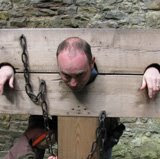In particular it's interesting to note how much of the current vision genuinely was present at the very start. I think people have sometimes assumed that EDL/Europeana were really conceived as a web portal first and a hub for content reuse second, and probably for some motivations that would make the nose of a John Birchian twitch frenetically. But from its very inception it was truly about encouraging interoperability in support of reuse, of stimulating the creative economy, and squeezing more value from the continent's heritage by allowing it to flow to wherever it's needed - at least that's how I read it, and my recent reading matter reinforces that. I won't labour the point any more, I will simply quote extensively from the eContentPlus Work Plan for 2005 (which was actually a plan for work to be done/money spent from 2006, the year before EDLnet kicked off)
Cultural and scholarly institutions, including archives, libraries and museums, are developing or creating digital collections, either by digitising or by acquiring digital resources. Though often described on institutional web-sites, these resources lack visibility at European and global level, because there is insufficient interoperability between existing networks, across types of cultural organisation and collection, and across different types of content. This is aggravated by the range of different legacy systems and practices for describing cultural and scientific resources.
Effective access and re-use requires an infrastructure which can support a range of functions, including: discovery of collections and of individual items; disclosing conditions for and authenticating use; and integrating tools, such as thesauri and ontologies, to enable multilingual/multicultural access and use. Re-use (aggregating and creatively adding to this content) also requires enriched digital objects which can eventually bedelivered through these services, supporting new economic and business models and user communities.
eContentplus aims at leveraging the multilingual availability of significant assets of digital cultural, scientific and scholarly content by supporting the development of interoperable collections and objects - on which multilingual and cross-border services can be built - and by supporting solutions to facilitate exposure, discovery and retrieval of these resources. Actions should increase the opportunities and scope for accessing these resources, tackle multilingual issues, and support the emergence of enriched cultural content. There are two complementary objectives for the work in this area: promoting an enabling infrastructure in support of access and use; and stimulating content enrichment.
[quoted from eContentPlus work programme 2005 p.10]

No comments:
Post a Comment